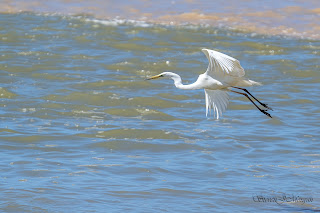Back on 27th of March I
returned to Gibraltar for the second of my three planned trips to ‘The Rock’ in
2024. Fellow Amigo Mark ‘Slasher’ Cutts had remained at Jews’ Gate Bird
Observatory, as the ‘ringer in charge’, since my previous departure on 21 Feb
24, and we enjoyed another week together along with two other UK ringers Pete
and Kate. As before, I managed to enjoy a day across the border in Spain after
accepting a generous invite from local birder and photographer Steve Morgan,
who was accompanying fellow locals Mark R and John to Brazo del Este Nature
Park. As stated in a previous Blog entry I arrived in Gibraltar during the
wettest week in fifty years (my inbound flight being diverted to Malaga in
Spain), and up until thirty minutes before I was due to meet Steve the rain
didn’t relent. Fortunately, the rain did finally stop at 05:00 and, apart from
water dripping off the overhanging trees, I stayed dry during the walk down
Engineers Road for my lift at 05:30 into Spain.
 |
| Great White Egret and Grey Heron, Brazo del Este NP – 1 Apr 24 (photographed by Stephen Morgan) |
The day didn’t disappoint, and the
highlight for all four of us was the spectacle of multiple Black Kites, a species
seen in the hundreds and thousands from Gibraltar, catching fish Osprey style.
Having already accumulated a decent day list, we were heading out of Brazo del
Este Nature Park when we drove past a conspicuous group of herons and egrets beyond
a gushing drain outflow into a river (Guadalquivir?). Mark pulled over to take
a few photographs of the birds that were standing close together and intently
looking at the water. Then to our astonishment a Black Kite drifted over and
dropped down to pluck a fish out of the water and fly off with its prey. The
herons and egrets also joined in on the act, occasionally lunging into the
water and cumbersomely flapped out of the water back to the waters edge. Then
another Black Kite flew over and plucked a fish from the water. It was apparent
that the Black Kites knew exactly what they were doing and had mastered the art
of effortlessly taking fish from the surface of the water. In the hour we
watched we saw at least twelve fish be taken by Black Kites.
 |
| Black Kite fishing, Brazo del Este NP – 1 Apr 24 (photographed by Stephen Morgan) |
Having read that the port of Servile
further upstream is served by a sea lock I suspect the river water is brackish.
As can be seen in an attached video there is a very clear demarcation between
the sediment laden river water and the clear, presumed fresh, water within the
discharge channel. Consequently, fish may have been getting stunned when they swam
into the ‘alien’ body of water to become easy pickings. Or maybe it was just the
fact that the fish were visible in the clear water of the channel. Whatever the
reason, the Black Kites, herons and egrets were well aware of the productive
food source within the discharge channel.
 |
| Black Kite fishing, Brazo del Este NP – 1 Apr 24 (photographed by Stephen Morgan) |
 |
| Great White Egret, Brazo del Este NP – 1 Apr 24 (photographed by Stephen Morgan) |
 |
| Great White Egret, Grey Heron and Yellow-legged Gull, Brazo del Este NP – 1 Apr 24 (photographed by Stephen Morgan) |
Good
birding,
Tony T BSc (Hons) GeoSci (Open)








































